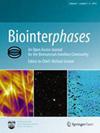Tutorials in vibrational sum frequency generation spectroscopy. III. Collecting, processing, and analyzing vibrational sum frequency generation spectra.
IF 1.6
4区 医学
Q4 BIOPHYSICS
引用次数: 6
Abstract
In this Tutorial series, we aim to provide an accessible introduction to vibrational sum frequency generation (VSFG) spectroscopy, targeted toward people entering the VSFG world without a rigorous formal background in optical physics or nonlinear spectroscopy. In this article, we discuss in detail the processes of collecting and processing VSFG data, and user-friendly processing software (sfgtools) is provided for use by people new to the field. Some discussion of analyzing VSFG spectra is also given, specifically with a discussion of fitting homodyne VSFG spectra, and a discussion of what can be learned (both qualitatively and quantitatively) from VSFG spectra.
振动和频生成光谱学教程。III、 收集、处理和分析振动和频生成谱。
在本教程系列中,我们的目标是提供一个可访问的介绍振动和频率产生(VSFG)光谱学,针对进入VSFG世界的人,没有严格的光学物理或非线性光谱学的正式背景。在本文中,我们详细讨论了VSFG数据的收集和处理过程,并提供了用户友好的处理软件(sfgtools)供该领域的新手使用。本文还对VSFG光谱的分析进行了一些讨论,特别是对纯差VSFG光谱的拟合进行了讨论,并讨论了从VSFG光谱中可以学到的东西(定性和定量)。
本文章由计算机程序翻译,如有差异,请以英文原文为准。
求助全文
约1分钟内获得全文
求助全文
来源期刊

Biointerphases
生物-材料科学:生物材料
自引率
0.00%
发文量
35
期刊介绍:
Biointerphases emphasizes quantitative characterization of biomaterials and biological interfaces. As an interdisciplinary journal, a strong foundation of chemistry, physics, biology, engineering, theory, and/or modelling is incorporated into originated articles, reviews, and opinionated essays. In addition to regular submissions, the journal regularly features In Focus sections, targeted on specific topics and edited by experts in the field. Biointerphases is an international journal with excellence in scientific peer-review. Biointerphases is indexed in PubMed and the Science Citation Index (Clarivate Analytics). Accepted papers appear online immediately after proof processing and are uploaded to key citation sources daily. The journal is based on a mixed subscription and open-access model: Typically, authors can publish without any page charges but if the authors wish to publish open access, they can do so for a modest fee.
Topics include:
bio-surface modification
nano-bio interface
protein-surface interactions
cell-surface interactions
in vivo and in vitro systems
biofilms / biofouling
biosensors / biodiagnostics
bio on a chip
coatings
interface spectroscopy
biotribology / biorheology
molecular recognition
ambient diagnostic methods
interface modelling
adhesion phenomena.
 求助内容:
求助内容: 应助结果提醒方式:
应助结果提醒方式:


